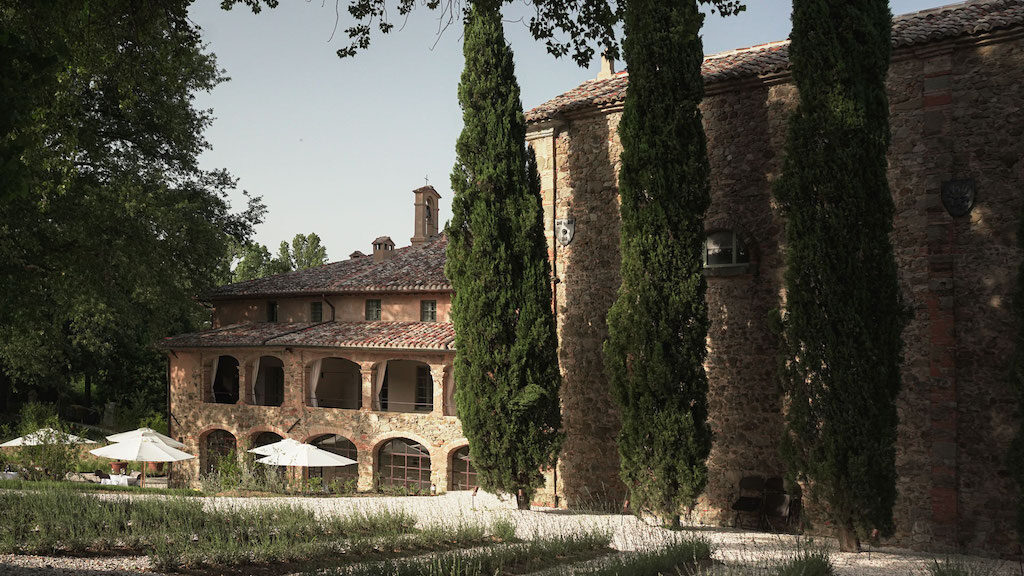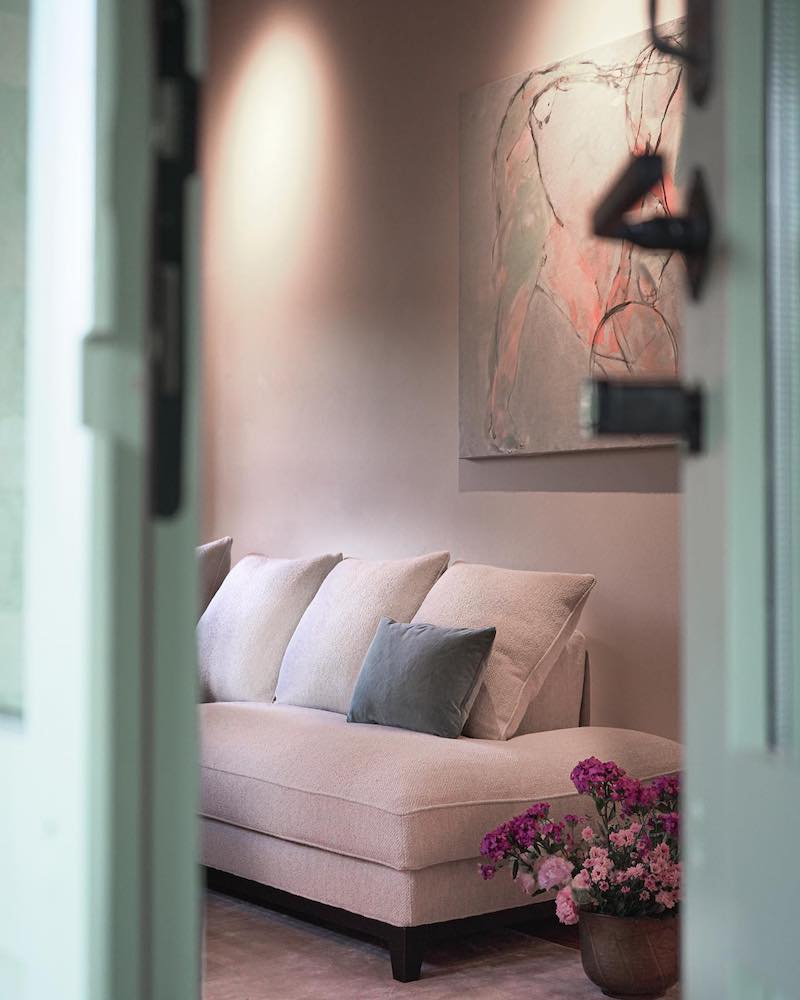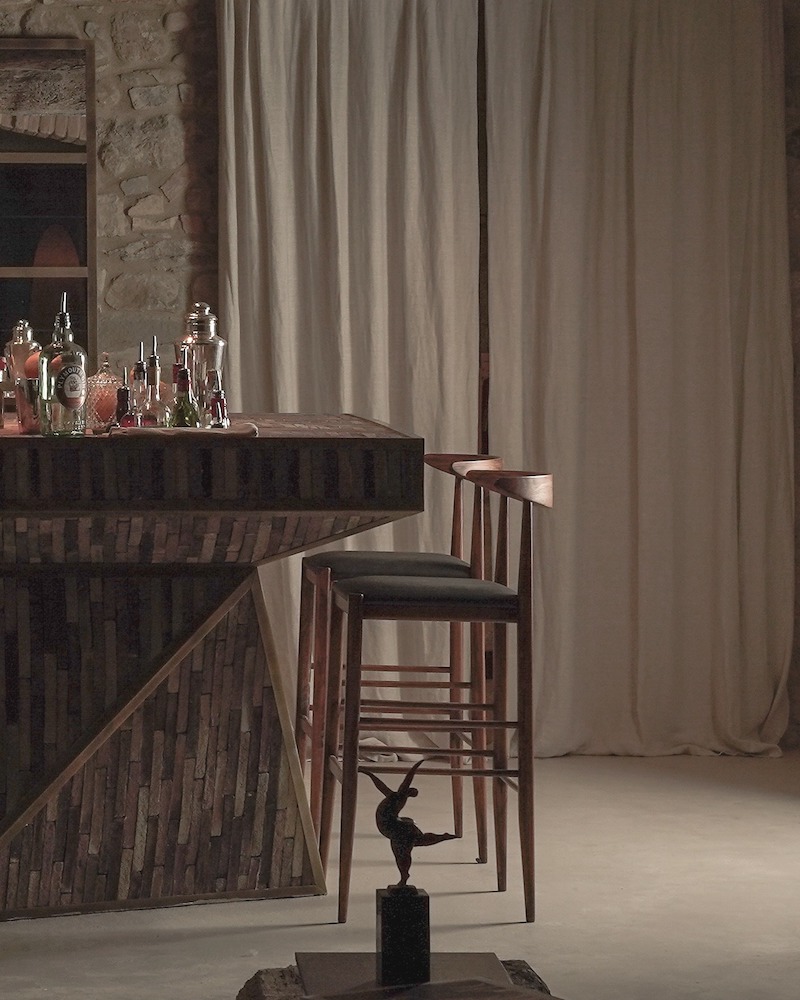
Original stone and brick structures are augmented by crisp, contemporary lines. A chapel gives way to a bespoke iron pergola. Herbal and floral aromas from the gardens waft through the air. Umbrella-topped tables surround a central piazza, and each room has its own distinct design. Plus, breakfast is offered all day, and guests become part of an intimate community. Combined, all of this results in a relaxing historical oasis with an undeniably modern feel.

Vocabolo Moscatelli opened its doors in August 2022 with a focus on rural tranquility and upscale regionality. The property, housed within a former monastery built in the 1300s and open year-round, pays homage to its history and the region of Umbria, while providing modern updates and amenities to instill a sense of serenity throughout a guest’s entire stay. Original beamed ceilings, heavy stone fireplaces, and soft wooden floors are met with open, airy spaces, fresh pops of color, and custom artworks and furnishings made by local artists and artisans. The result is a mixture of history and modernity, a property where memory coexists with timeless contemporary design.


“Vocabolo is a place where one feels at home and can feel the great green heart of Italy beat,” OriginalFrederik Kubierschky says. Born in Germany and raised in Italy, Kubierschky spent more than 10 years as Chef Concierge at some of Switzerland’s top five-star hotels. Bringing this expertise in guest experiences to Vocabolo Moscatelli, he and his partner Catharina Lütjens ensure that standout, customized service is backdropped by equally impressive and diverse structures.


To faithfully restore and renovate the monastery’s three buildings, Kubierschky and Lütjens enlisted Jacopo Venerosi Pesciolini of studio Archiloop, who also oversaw the interior design. Pesciolini designed every space—from the onsite restaurant and bar to the pool to the guest rooms and suites—individually. As a result, each area has its own identity, expressed through varied color palettes, materials, and furnishings. However, specific uniting elements, like wood floors, exposed terracotta brick and natural stone walls, and iron and brass detailing, are used throughout the property. Moreover, artworks adorning the spaces were curated by Matteo Pacini and created by more than 10 artists, including Louis Boujac, Domenica Regazzoni, and Massimiliano Poggioni. Additional décor was made by the Umbrian brand Endiadi Ceramics.


Of the 12 guest rooms and suites, eight are found in the main villa and four others in the nearby annex. As each room is individually designed, there are different pieces of furniture, colors, and layouts, but the overarching tone throughout is one of coziness and warmth. Some rooms boast four-poster beds forged by the century-old Umbrian blacksmith brand Lispi & Co., while others have bedframes handmade by the Tuscan design experts at Tosconova. Two suites in the main villa feature large terraces with furniture by Italian designer Paola Lenti and luxe soaking tubs overlooking the countryside. Rooms in the annex, meanwhile, have private gardens with lounge furniture by Venetian company Varaschin. Another Tuscan company, Samarreda, created the majority of built-ins, including wardrobes, in all rooms. Although every bathroom is also different, rich pops of color are always found in partially glazed terracotta tiles by Cotto Etrusco that line the showers and brass furnishings always abound.

Two unique highlights are suites designed with specific purposes in mind: the Bridal Suite and Spa Suite. The former features a bespoke mahogany sideboard and formal dressing area with an oversized mirror, while the latter has an in-room sauna and outdoor Jacuzzi. The Spa Suite, which has a private garden, can also be quickly transformed into a treatment room with the inclusion of a specially designed Murphy bed.

The main villa’s ground floor houses the Matite bar and Vocabolo Moscatelli restaurant, which is open to the public and children of all ages are welcome. Despite its location in a region known for its meat, the restaurant offers a plant-forward menu with local ingredients. Here, Umbrian cuisine is reinvented through vegetarian dishes; produce is sourced from suppliers around the corner as well as the onsite garden and orchard; and when meat or seafood is on the menu, it always has certified fair-treatment provenance. At Matite, expert mixologists craft unique cocktails from a bar stocked with spirits housed in clear, color-coded bottles—a conscious decision made to replace what is usually a long stretch of labels. The bespoke terracotta-and-brass bar is centrally positioned, almost like a live cooking station, to encourage guests to gather and mingle around it. Similarly, the restaurant features a four-meter-long mahogany dining table, enabling multiple parties to share a meal. Additional custom pieces include marble dining tables and coffee tables made from repurposed wood ceiling beams.

Custom sunbeds and side tables by Lispi & Co. and lounge chairs by Paola Lenti surround the pool, and a custom fireplace in Microcement sits squarely between the villa, church, and swimming area. Furthermore, there’s a one-hectare Mediterranean garden designed by Fabiano Crociani, where guests can wander through vegetable plants and a grove of ancient fruit trees native to Umbria, raised by agronomist Isabella Dalla Ragione and her nonprofit, the Arboreal Archaeology Foundation.
Inside and out, every space is designed for leisurely interaction, inviting guests to meet each other, relax at their own pace, and tune-in to their surroundings. Vocabolo Moscatelli welcomes guests aged 14 and over, and the entirety its grounds are accessible 24/7. Breakfast, too, is served all day every day.

Location
Vocabolo Moscatelli is located on the outskirts of Calzolaro, a hamlet in Umbria, Italy. The region is known for hills rich with farmland, twisting vineyards, and medieval towns. Only nine kilometers from the Tuscan border, nearby activities include trekking, hiking, biking, truffle hunting, wine tastings, taking pottery classes in the onsite chapel hosted by Endiadi ceramics or local painting classes, and visiting cultural sites in towns including Assisi, Cortona, Spoleto, Terni, and Perugia. The Adriatic or Tyrrhenian seaside can be reached via a two-hour drive. The nearest airport is the Umbria International Airport.















Comments and reviews